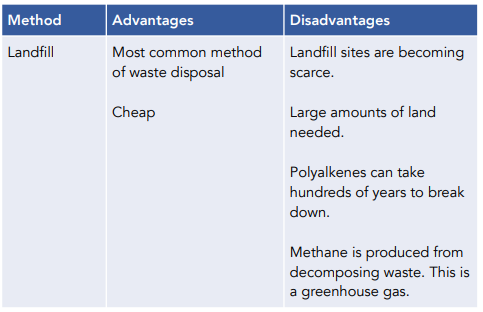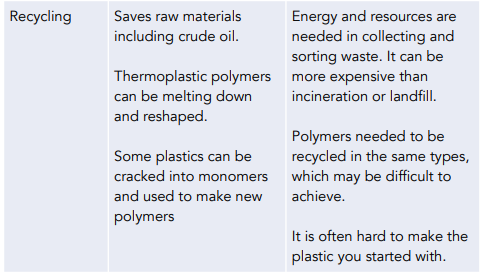Polymer Disposal (A-Level Chemistry)
Polymer Disposal
Disposal of Polymers
Plastics are synthetic polymers.
Plastics are widely used but they are difficult to dispose: they either are non-biodegradable or if they are, they take very long to break down.
There are different ways of getting rid of plastics:
• Landfills – Plastics which are difficult to sort or recycle or that aren’t plentiful enough to separate, are usually buried in a landfill.
• Incineration – Waste plastics are burnt in an incinerator.
• Recycling – After sorting, plastics can be recycled in different ways. Plastics can be melted and used to make new objects by remolding. Alternatively, cracking can be used to split plastics into their monomers, from which other plastics or chemicals can be made.
Advantages and Disadvantages
The table shows the advantages and disadvantages of different methods of polymer disposal.



Polymer disposal refers to the process of safely disposing of or recycling synthetic polymers, which are commonly used in everyday items such as plastic bottles, bags, and packaging.
In A-Level Chemistry, understanding the process of polymer disposal is important as it highlights the importance of sustainable practices and the impact of synthetic polymers on the environment. It also provides an opportunity to learn about the various methods of polymer disposal and their efficiency.
There are several methods of polymer disposal, including:
Recycling: melting down and repurposing the polymer into a new product.
Incineration: burning the polymer to convert it into ash and gaseous products.
Landfilling: burying the polymer in a designated landfill site.
Biodegradation: breaking down the polymer into natural substances through the action of microorganisms.
The efficiency of each method of polymer disposal varies and depends on several factors such as the type of polymer, the disposal method used, and the conditions under which the disposal takes place. For example, recycling is the most sustainable method, but it may not always be possible for certain types of polymers. Incineration is efficient in terms of volume reduction, but it can release harmful gases into the atmosphere.
Incorrect or inadequate polymer disposal can have significant environmental impacts, such as:
Release of harmful chemicals into the air, water, and soil.
Contamination of soil and water resources.
Accumulation of plastic waste in landfills and the natural environment.
Negative impacts on wildlife and ecosystems.
We can reduce the environmental impact of polymer disposal by:
Properly sorting and recycling polymers.
Minimizing the use of single-use plastic items.
Properly disposing of polymers in designated landfill sites.
Promoting the use of biodegradable polymers and alternative materials.






Still got a question? Leave a comment
Leave a comment